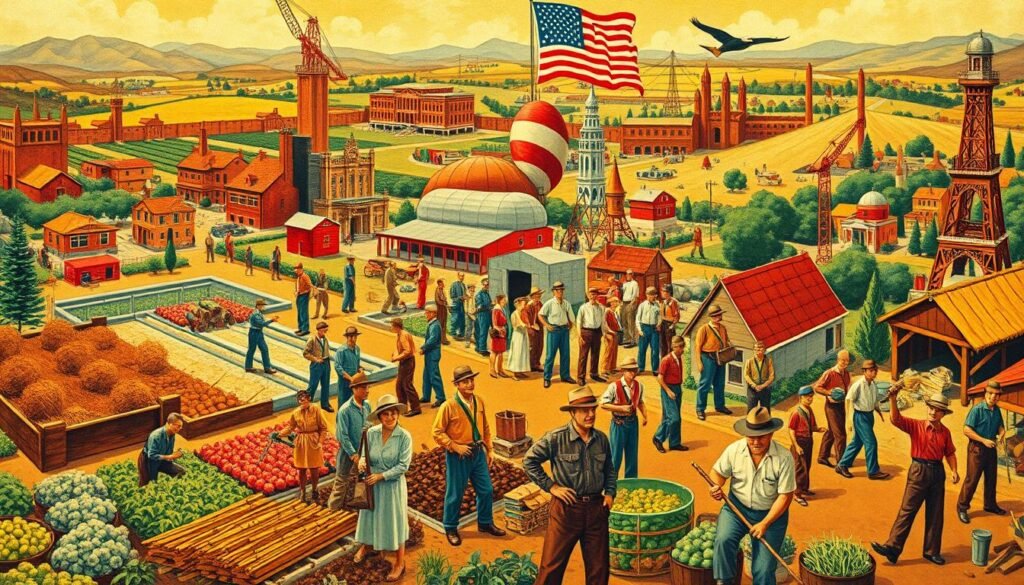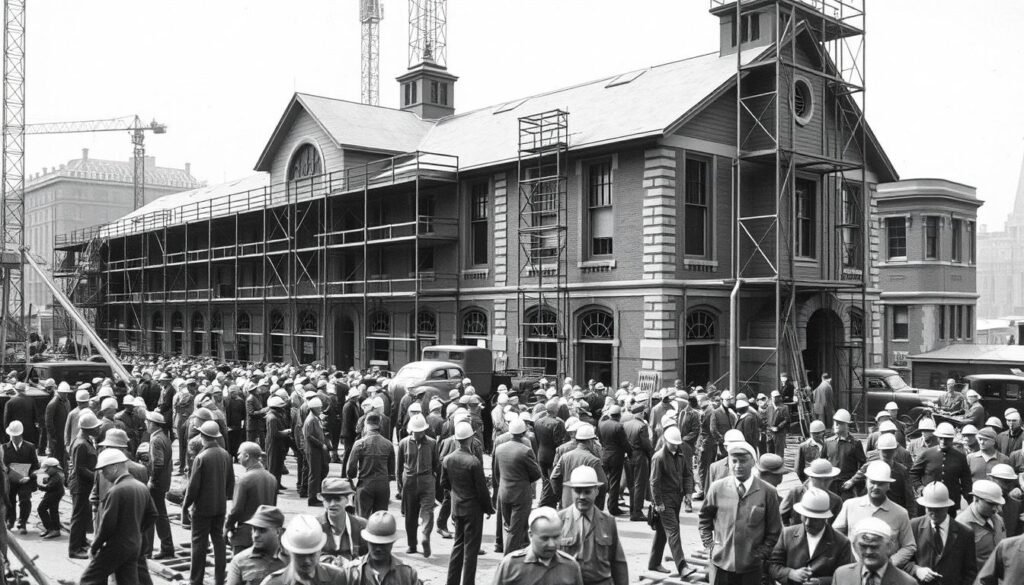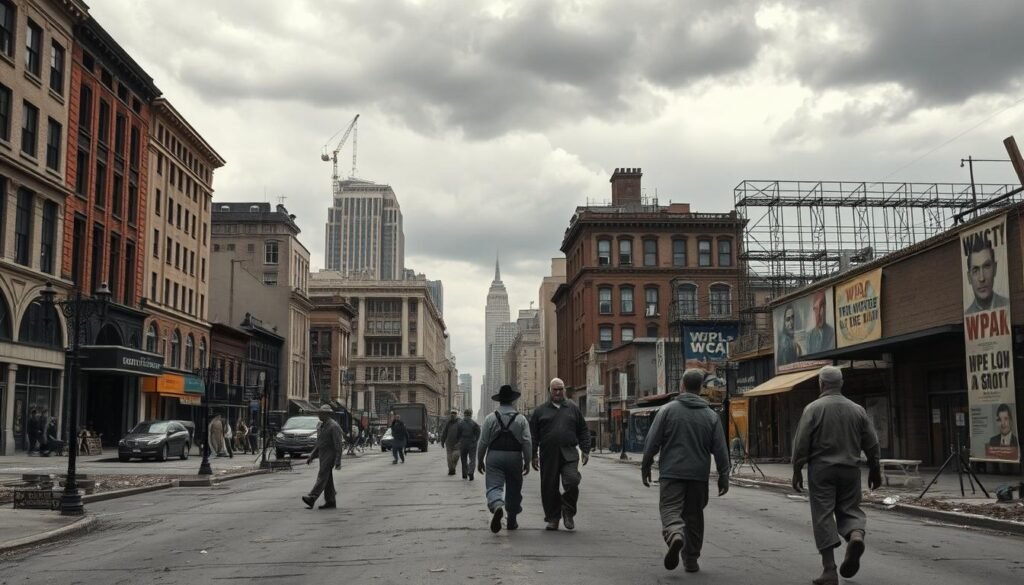From 1935 to 1943, the Works Progress Administration (WPA) was a beacon of hope. It gave jobs to over 8.5 million Americans during the hard times of the Great Depression. President Franklin D. Roosevelt started the WPA to fight unemployment and revive the economy.
Projects like building over 620,000 miles of streets and more than 10,000 bridges were launched. This built up the country’s infrastructure which is still in use by millions. Starting with a budget of about $1.3 billion each year, the WPA was key in helping many families survive during tough economic times. For more about the WPA, check out this link.
Key Takeaways
- The WPA employed over 8.5 million people from 1935 to 1943.
- At its peak in November 1938, the WPA employed about 3.3 million individuals.
- WPA projects included the construction of 620,000 miles of streets and 10,000 bridges.
- Federal Project Number One hired lots of artists, improving America’s cultural scene.
- The initial funding for the WPA was $4.9 billion, showing the government’s dedication to recovery.
- But, WPA projects showed gender disparities, with women making up only 13.5% of workers by 1938.
- Crucially, the program also lifted the spirits of its workers during hard economic times.
Introduction to the WPA
The Works Progress Administration (WPA) started during tough economic times, addressing the issues from the WPA Great Depression. It was formed in 1935 by President Franklin D. Roosevelt. The program’s goal was to deal with high unemployment, which affected nearly a fifth of the population. The WPA created federal jobs, giving over eight million people a chance to work and help their communities.
The WPA aimed to preserve the dignity and self-respect of workers by giving meaningful work, not just aid. This approach allowed people to gain skills and improve infrastructure at the same time. It led to the building of around 29,000 new bridges and over 280,000 miles of roads.
Supporting the nation’s culture was also key. The WPA put about $27 million into arts, helping about 5,300 visual artists at its peak. This effort showed the WPA’s broader goal of not only economic recovery but also cultural enrichment. For more details on the WPA’s influence, readers can check out the Works Progress Administration.
Understanding the Great Depression
The Great Depression started in 1929, changing America deeply. By its peak, about 25% of workers had no jobs. Over 12 million people were out of work because of this crisis.
Many things caused this tough time. The stock market crash, banks failing, and less buying by people played big roles. Businesses had a hard time and many had to let workers go. This made life hard for families everywhere.
There was a big need for help for the jobless. The government started programs like the Works Progress Administration (WPA). These aimed to give jobs to the unemployed and help the economy recover. Even with these hard times, such efforts were a big help to those who needed it most.
WPA Great Depression: Overview and Significance
The Works Progress Administration (WPA) was key during the Great Depression. It gave jobs to millions of jobless Americans. Founded in 1935, the WPA was President Roosevelt’s plan to deal with the country’s economic problems. Through public works, it aimed to reduce joblessness and give workers hope and respect.
Creation of the WPA
The WPA began to tackle the 1930s’ high unemployment. It planned to hire 3.5 million Americans, using about $5 billion in its first year. The WPA was special because it focused on creating real jobs, not just handouts. By 1943, it had helped about 8.5 million Americans. Harry Hopkins, the first administrator, guided the WPA in its early days.
Goals of the WPA
The WPA’s goals were based on a deep understanding of social and economic issues. It aimed to improve public facilities and give people work. Projects included building schools, hospitals, roads, and bridges. The Federal Project Number One even supported artists, writers, and musicians. This ensured the arts grew with infrastructure. In North Carolina, the WPA employed 125,000 people and finished 4,000 projects in five years.
Roosevelt Administration and the New Deal Programs
The Roosevelt administration was a key time in American history. It brought in the New Deal programs during the Great Depression. These efforts aimed at not just quick fixes but ensuring long-term economic health. The New Deal included many programs to help with relief, recovery, and reform, changing how the government handled the economy.
Overview of the New Deal
The New Deal had lots of parts, like the Federal Emergency Relief Administration (FERA). FERA gave over $3 billion to help state and local governments. This money helped employ about 20 million people in just two and a half years. Also, the Works Progress Administration (WPA) worked on improving infrastructure, creating jobs from building bridges to schools.
Impact of the Roosevelt Administration
The Roosevelt administration made a big difference. In 1935, the unemployment rate was 20 percent. New Deal programs started to lower this number. Things like the Social Security Act of 1935 brought in pensions and unemployment insurance. The Wagner Act improved labor rights, letting workers organize for better conditions.
These steps didn’t just help the economy short-term. They also laid the groundwork for a fairer society. This shows how important the New Deal programs are in American history. For more about challenges of that time, visit this informative article on depression treatment.

Public Works Projects and their Contributions
The Works Progress Administration (WPA) era was a major time of change in the United States. It focused on big public works projects. These efforts tackled the Great Depression and helped build a better future in infrastructure. By giving jobs on important projects, the WPA boosted the economy and met key infrastructure needs.
Infrastructure Development
The WPA took on huge and important public works projects. It supported the building of needed things like over 800 airports. One notable work was LaGuardia Airport in Queens, New York, an essential travel center. Other key projects were the Chickamauga Dam on the Tennessee River and the San Francisco-Oakland Bay Bridge. This bridge, opened in 1936, was the world’s longest at the time.
- Over 650,000 miles of roads constructed
- 125,000 public buildings erected
- 75,000 bridges built
- Major transit projects like the Lincoln Tunnel, initiated in 1937
- School infrastructure projects totaling 7,488 buildings
Employment Opportunities Created
Public works projects created millions of jobs during the economic downturn. Workers earned money and learned valuable skills. The PWA funded more than 34,000 projects. For every person hired directly, two more jobs came indirectly. This vast effort made the labor market stronger. It also brought hope and a sense of purpose to workers during hard times.
| Type of Project | Number of Projects | Employment Generated |
|---|---|---|
| Road Construction | 11,428 | Approximately 34,000 direct jobs |
| Public Buildings | 125,000 | Varied, extensive indirect employment |
| Bridges | 75,000 | Significant labor engagement |
| Aeronautical Projects | 800+ airports | Countless related jobs in aviation |
The overall effect of these public works projects is huge. By focusing on building infrastructure and creating jobs, the WPA greatly helped America become stable economically. Its impact is still felt today, supporting growth.
Unemployment Relief through WPA Initiatives
The Works Progress Administration (WPA) was key in helping those without jobs. It created jobs for many Americans. These efforts helped reduce the economic hardships during tough times.
As job losses hit hard, the WPA’s work became a symbol of hope. It helped the country move towards recovery.
Statistics on Employment
About 8.5 million people found work through the WPA, showing the impact of government action. At its 1938 peak, over 3.3 million were employed by it. These numbers highlight the WPA’s significant role during the Great Depression.
The Role of WPA in Reducing Unemployment Rates
The WPA played a vital role in lowering unemployment. It switched from direct relief to offering work relief. By 1935, it took over from FERA and expanded job offerings. This change meant many could find the work they needed in hard times.
| Year | WPA Employment (millions) | Financial Allocation ($ billion) |
|---|---|---|
| 1935 | 0.1 | 1.4 |
| 1936 | 1.1 | 2.5 |
| 1938 | 3.3 | 3.1 |
| 1943 | 1.5 | 2.0 |
Federal Jobs Programs and Workforce Empowerment
During the Great Depression, programs like the WPA were vital in empowering workers. They aimed to tackle high unemployment rates, helping millions to find jobs. In Toledo, Ohio, unemployment hit 80% in 1933. Lowell, Massachusetts, saw rates close to 90%.
The WPA didn’t just offer short-term help. It made people more self-reliant, moving away from traditional welfare. This approach welcomed all types of workers, including the youth and those on the fringes. By 1938, about 3.3 million were working in WPA projects. This was crucial for the country’s recovery and for building its infrastructure.
The skills learned in these jobs led to lasting advantages. Workers became more skilled and confident. The National Labor Relations Act of 1935 boosted this trend by supporting the rights of workers. This allowed 8 million to join unions by 1937, further empowering American workers.
Here’s a clear overview of how federal jobs programs have empowered the workforce:
| Federal Jobs Programs | Year Established | Impact on Workforce Empowerment |
|---|---|---|
| Works Progress Administration (WPA) | 1935 | Created jobs for 3.3 million individuals, focusing on infrastructure development and skills training. |
| National Apprenticeship Act | 1937 | Established modern apprenticeship frameworks, providing training for skilled positions. |
| Comprehensive Employment and Training Act (CETA) | 1973 | Offered job training and support for low-income and displaced workers. |
| Workforce Innovation and Opportunity Act (WIOA) | 2014 | Focused on skills training and supportive services, aiming to enhance employment opportunities. |
These programs did more than just fill current job openings. They prepared workers for future economic changes. This shows the lasting effect of such strategies on our economy. It highlights the critical role of federal jobs programs in building a strong and skilled workforce.
Construction Initiatives Under the WPA
The Works Progress Administration (WPA) changed America’s infrastructure during the Great Depression. Key projects like the major projects WPA and the Hoover Dam were iconic. They impacted both urban and rural places. These efforts showed a strong commitment to improve transportation and public spaces.
Major Projects and Accomplishments
The WPA gave jobs to over 8.5 million people for various projects. In Georgia, it paved 85 miles of roads and fixed old ones, helping communities. They also built the Dunwoody School auditorium, costing $9,000 in 1935, and a canning plant near Chamblee High School. These projects helped places that needed it the most.
They also tackled essential infrastructure like the DeKalb County water system in 1940, helping places including Emory University. Public parks, like the Chastain Park golf course and amphitheater, got better too. These upgrades by the WPA brought many benefits.
Long-term Benefits of WPA Projects
The impact of the WPA’s work is still felt today. Many built facilities are still used, showing the program’s high-quality work. It was key in the nation’s economic recovery. By 1941, the WPA had funded 28,000 miles of roads, 1,000 bridges, and many libraries and parks.
This legacy did more than build; it helped communities and supported them during hard times. Good building practices meant these places lasted and helped future generations. This shows how the WPA’s work is still valuable in American life today. It’s a big part of how the U.S. bounced back from the Great Depression and grew stronger.

Cultural Contributions of the WPA
The WPA made big cultural contributions during the Great Depression. The Federal Project Number One was a big deal. It hired over 10,000 artists. These artists worked in music, theater, writing, and fine arts. They made murals, prints, and performed in public, showing American life’s many sides during hard times.
The Federal Art Project was a key part of these efforts. It helped unemployed artists find work. The project made art for everyone to enjoy. Artworks were placed in schools, hospitals, and government buildings. This brought art into daily life.
Community art centers grew with the support of WPA art programs. They held shows and workshops for locals. This helped communities express themselves, even those often ignored. America’s art scene blossomed in the 1930s, showing the country’s resilience.
| Arts Program | Key Elements | Impact |
|---|---|---|
| Federal Art Project | Employed over 10,000 artists, produced murals, prints, and more | Increased accessibility of art in public spaces |
| Theater Project | Supported community theater productions and performances | Revitalized local arts scenes and provided entertainment |
| Music Project | Encouraged the development of musical programs and performances | Fostered appreciation for various music genres |
| Writers’ Project | Documented local histories and produced literary works | Preserved regional narratives and cultural heritage |
In short, the WPA’s cultural work, especially through Federal Project Number One, sparked creativity and shared cultural experiences during tough times. These arts programs have deeply impacted America’s culture. They highlight how important arts are for community building and saving history.
Criticism and Controversy Surrounding the WPA
The WPA stirred up plenty of debate while it was active. It aimed to fight unemployment but didn’t win everyone’s praise. Critics often pointed out issues with criticism WPA‘s cost and how effective it really was. They argued that the money spent on WPA projects was too much for taxpayers to bear, leading to accusations of wasting funds.
Public Perception and Critiques
Opinions on the WPA were divided. For some, it was a glimmer of hope that offered jobs and boosted the economy through community projects. However, critics believed it made people overly reliant on government help. Despite creating job opportunities, the WPA was also seen as inefficient by some. They noted that certain workers didn’t put in genuine effort, affecting the program’s reputation.
Political Implications
The WPA had a big impact politically. It helped the Democratic Party gain the support of lower-income citizens by providing jobs and building infrastructure. This move was seen by many as a way to broaden political power, sparking party conflicts. The WPA’s role in driving voter support was clear, showing its importance went beyond economic aid. It played a key part in the political shifts of the Great Depression era.

The Legacy of the WPA and its Impact on Modern America
The WPA’s legacy is a crucial part of American history. It made big changes during the Great Depression. About 8.5 million people found jobs through the WPA, helping the nation grow in different areas. This effort fought unemployment and improved the country’s infrastructure.
The WPA played a big role in modern America. It built roads, bridges, schools, and parks we still use. States like New Hampshire, Minnesota, New Mexico, and Wyoming saw a lot of growth. The WPA didn’t just fix the economy; it also kept American culture alive. It helped artists and encouraged creativity through the Federal Art Project.
The Slave Narratives project was important, too. It collected stories that help us understand America’s diverse heritage. Now, legacy tours show off the historical and architectural importance of WPA projects. This keeps the WPA’s contributions alive today.
The WPA talks to us about public policy and jobs today. It showed how to grow by taking care of the environment and communities. With today’s challenges, the WPA’s ideas help us find ways to make America resilient and successful.
| WPA Contributions | Modern Implications |
|---|---|
| Employment of 8.5 million people | Foundation for job creation strategies |
| Infrastructure improvements across multiple states | Ongoing maintenance and development of public works |
| Support for the arts through various projects | Continued investment in cultural and artistic endeavors |
| Documentation of American stories and histories | Promotion of diversity and inclusion in contemporary narratives |
| Environmental conservation efforts | Foundation for modern sustainability initiatives |
Conclusion
The WPA was a key player in America’s battle with the Great Depression. It laid the foundation for recovery. By creating jobs through public works, it helped people and enriched culture too. By 1939, unemployment was much lower, showing the power of these projects.
The WPA teaches us about government’s role in crises. Its work didn’t just stop after the Depression. It influenced how we recover from big problems even after World War II ended in 1945. This era showed the government taking a bigger part in the economy and people’s lives.
The WPA did more than just fix immediate problems. It showed America’s strength in industry could also help allies in war. Franklin D. Roosevelt saw the Great Depression as a battle to be won. His efforts led the country toward a stronger economic future.